A nation grieves
It was in the world news early this week. Last Tuesday at 8:10 in the morning, a 7.2 magnitude earthquake struck the tourist island province of Bohol situated in the central Philippines. The power of such temblor was equivalent to 32 atomic bombs, and it flattened houses, crumbled buildings, destroyed bridges, cracked roads and, as of last count, claimed the lives of over 170 people, mostly buried under piles of rubble. The death toll is expected to mount as more bodies are retrieved from under collapsed structures. I have featured Bohol (and the nearby province of Cebu which was also heavily affected) in many previous posts. Both provinces are popular tourist destinations. Bohol in particular is known for its Chocolate Hills , the rare Tarsier, the green Loboc River, pristine beaches and its centuries old churches. Aside from the lives that were lost, the nation grieves with the destruction of 10 heritage churches, all priceless national treasures, some dating back to the 1500s. I had the opportunity to photograph some of these beautiful churches during my early travels, and below I have paired my pictures of them with the pictures I saw in the news in the aftermath of the quake. For us photographers who enjoy capturing old, historic structures, these are heartbreaking sights:
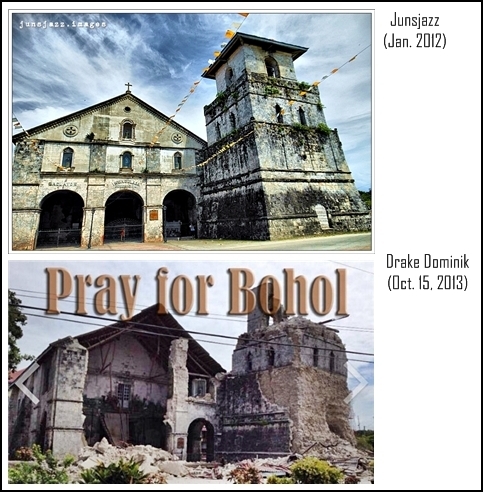 The Church of Our Lady of the Immaculate Conception in Baclayon town, Bohol. Built in 1717.
The Church of Our Lady of the Immaculate Conception in Baclayon town, Bohol. Built in 1717.
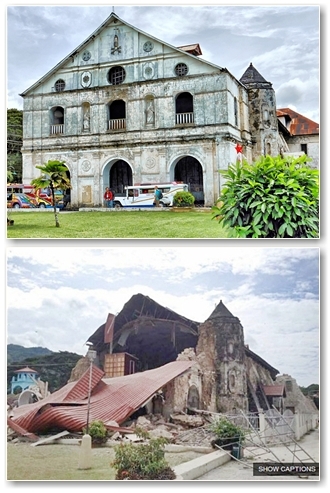 The Church of San Pedro in Loboc, Bohol, originally built in 1602.
The Church of San Pedro in Loboc, Bohol, originally built in 1602.
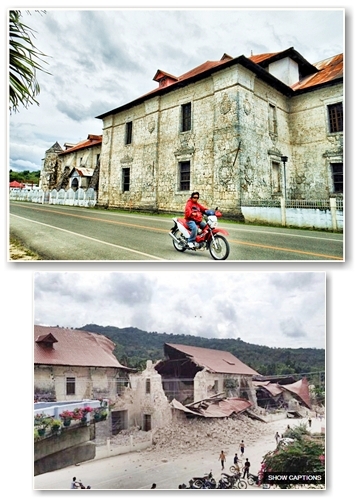
Another picture of the Loboc Church, from the side.
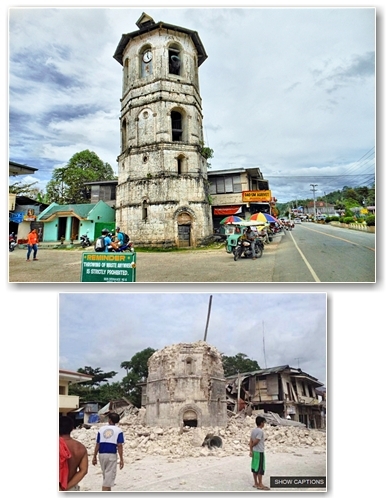 The original bell tower of Loboc Church stands some 100 meters away from the church structure. Now it’s just a stump on the ground.
The original bell tower of Loboc Church stands some 100 meters away from the church structure. Now it’s just a stump on the ground.
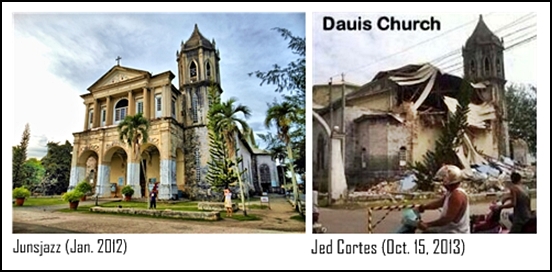 The Church of Our Lady of the Assumption in Dauis, Bohol built by Jesuits in mix style but influenced by Byzantine and Romanesque architecture.
The Church of Our Lady of the Assumption in Dauis, Bohol built by Jesuits in mix style but influenced by Byzantine and Romanesque architecture.
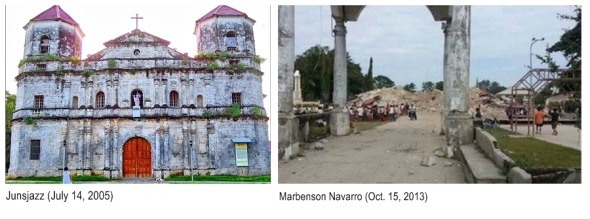 The Church of Our Lady of Light in Loon, Bohol was the biggest church in the province, built in 1753. The whole structure was pulverized to the ground.
The Church of Our Lady of Light in Loon, Bohol was the biggest church in the province, built in 1753. The whole structure was pulverized to the ground.
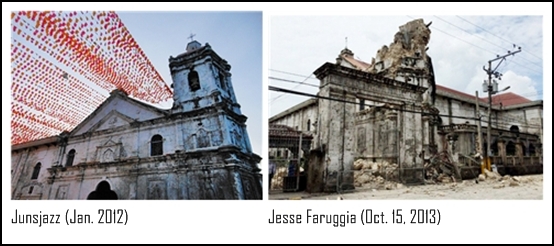 The Minor Basilica of the Holy Child in Cebu City, founded in 1565. It’s belfry fell off.
The Minor Basilica of the Holy Child in Cebu City, founded in 1565. It’s belfry fell off.
These old churches were built with materials during those times – coral stones, mud bricks, limestones – and are most fragile. Throughout their history, they have been subjected to fires, typhoons, previous earthquakes and even World War II. They were the first to come down during the powerful quake this week. Experts are assessing if some of them can be rebuilt, while others like the Loon Church which was flattened, may have a new church built on the site. I am quite fortunate to have captured the beauty and grandeur of these churches in their original condition before the disaster. Now I have them immortalized in images, and preserved in my memory as I saw them in their full glory.
Note: These churches are featured in Junsjazz Images & Inspiration Digital Magazine Issue #2.
The mark of its maker
Outlines, forms, shadows, shapes, lines, light, tones, textures – these are the ingredients of black and white photography. Have fun with your imagery. Play with the elements and composition. Love the light. Bask in contrast. Experiment. Crop to exclude and emphasize. Discover. Assess with your eye. Process with your brain. Capture with your heart. With these, I can offer no other more meaningful tips when it comes to making monochrome images. With tools and knowledge, it all boils down to you – the creator and artist. After all, each picture is an individual mark of its maker.
Weekend Inspiration 36
Thank you everyone for the follows, likes, visits and views during our Church Week. I hope you enjoyed the images and the articles. Join me next week when we embark on another picture series. Wishing you all a restful and refreshing weekend!
To HDR or not
Capturing High Dynamic Range (HDR) photos and processing them is one of my photographic enjoyments. Shooting a scene in its normal exposure sometimes doesn’t cut it, especially if your light is on the side or back of your subject. In that case, your subject is dark and becomes just a silhouette. Using your camera’s bracketing feature (to take three different exposure shots) or shooting in RAW format allows you to create HDR images, and post processing them later. I usually go for the former or if ever I capture in RAW I convert the image first to jpeg or tiff (to minimize noise) then process. We will not do an HDR tutorial here, but I will share my viewpoint on why I do HDR on certain subjects and scenes. First let me point you to some great links:
What is HDR Photography? by Rhommel Bernardino from PictureCorrect
How to Create High Dynamic Range Photographs from wikiHow
Photo Gallery: How to Take HDR Pictures from National Geographic
HDR allows you to present an image with all the nuances of light and the subtleties of color.
Hence HDR images are quite colorful (though this isn’t always so) with deep contrasts. When done right, you can produce images that pop right out. I am fond of HDR but only on certain subjects such as landscapes and, you guessed it right, churches. The key phrase here is “when done right.” In HDR we have the tendency to amp it up to get that “ah” and “omph” and likening it to too much salt, it spoils the broth. The standard for HDR is realism. It must look natural, but enough to bring out the details. Note the cracks, exposed bricks and signs of age on the walls of the church pictured above, or the deep yet fading (or I should say peeling) colors of the church below. In a non-HDR image, you will just see a relatively smooth wall with a few jagged lines representing cracks. So much more are exposed – light, details and information using the HDR technique. Here is an excerpt from Rhommel Bernardino in his article What is HDR Photography? (it’s the first link above):
With HDR technology, photographers can compile different photographs taken at variable exposures. Not only that but also this technique allows photographers create images with an excellent light detail, which is not possible in single shot taken by ordinary cameras. By using HDR cameras, photographers can capture excellent still photographs, in overexposed as well as underexposed settings. Though photographers have the freedom of adding several effects to the photographs, it is always recommended to keep the image as realistic as possible.
Night churches
As photographers we all know the challenges of shooting at night or in low light conditions. We need a tripod, we need to bump up the ISO, we need a “fast” lens (one with large aperture to take in more light). But I won’t delve on a tutorial on night photography, there are lots of sites that provide that. Instead let us focus on capture and composition, still with churches as subjects but taken at night.
The two images are of the Cebu Cathedral, the one above was taken last year while that below was taken several years earlier. The Cebu Cathedral has an expansive facade, so unless you have a wide angle lens you have to move way back to capture its entire front. Capturing it up front however gives you a singular, non-dimensional perspective unlike when taking a picture of it from one side. In the above photo, slanted lines give you an idea of the structure’s dimension – it is large and wide. A technique to show size and dimension is to include people or a person as reference. Note the size of the woman entering the main door. The sheer size and grandeur of the Cebu Cathedral, splendid in golden light, are emphasized. If ever there is a tinge of light remaining in the sky such as the dusk scene below you can still capture silhouette images. I was fortunate that the lamps in the front courtyard were already lighted hence providing me an appropriate foreground.
I have mentioned several times in previous posts that photography is the art of observation. Look before you shoot. You may be afforded just seconds to observe in action situations and moving subjects, so you have to be fast with your eye and finger combination. With churches and other static, immobile subjects you have all the time in the world to assess, plan and observe before you ever press that shutter. In other words, walk around, find angles, change perspective, look for details. I recall a quote from a noted photographer who said that one is likely to be rewarded with a great image if he put some planning into that capture and was deliberate with his shot, rather than leaving everything to chance. Oh, I say amen to that!
Belfry
The first thing I notice in a church from the outside is the belfry, or the bell tower. Since they are usually the tallest part of a church structure, they have that prominence in the overall architectural design underscoring their functional importance. There are churches with dual belfries while others have singular towers. Here are samples of belfry images from my collection:
 Baclayon Cathedral, Bohol Province
Baclayon Cathedral, Bohol Province
 Guimbal Church, Iloilo Province
Guimbal Church, Iloilo Province
 Basilica de Sto. Nino, Cebu City
Basilica de Sto. Nino, Cebu City
 Batangas Basilica, Batangas City
Batangas Basilica, Batangas City
 The old Loboc Church Belfry, Bohol Province
The old Loboc Church Belfry, Bohol Province
 Sto. Nino Church, Tacloban City
Sto. Nino Church, Tacloban City
 San Agustin Church, Intramuros, Manila
San Agustin Church, Intramuros, Manila
Interesting interiors
For me, the interiors of churches are as much of a photographic delight as its exteriors. The grandeur in the outside is complemented or even topped off by the elaborate inside. You’ll find ornate pieces, sophisticated ceilings, fancy wrought-iron designs, luxurious stained-glass windows, and hundreds of other items of interest. It’s literally a photographer’s heaven.
 Church of Santo Tomas de Villanueva, Miag-ao town, Iloilo province
Church of Santo Tomas de Villanueva, Miag-ao town, Iloilo province
Drawn to symmetry
Article Excerpt:
Why is architectural symmetry so satisfying? As Leonardo da Vinci’s famous drawing demonstrated, it reflects the human body, which has a right side and a left, a back and a front, the navel in the very center. Du Sautoy writes that the human mind seems constantly drawn to anything that embodies some aspect of symmetry. He observes that “[a]rtwork, architecture and music from ancient times to the present day play on the idea of things which mirror each other in interesting ways.” When we walk around a Baroque church, we experience many changing views, but when we walk down the main aisle—the line along which the mirror images of the left and right sides meet—we know that we are in a special relationship to our surroundings. And when we stand below the dome of the crossing, at the confluence of four symmetries, we know we have arrived.
~Witold Rybczynski from his article Mirror Images: Why is symmetry so satisfying?
A treasure trove
The above is the facade of the St. John of Sahagun Parish Church in the historic town of Tigbauan, Iloilo province. Nothing really extraordinary in its Baroque-inspired exteriors, but wait till you get inside. Whoa, don’t scroll down and enter just yet! Before that, let me first share a description from Wikipedia:
Tigbauan, is one of Iloilo’s treasure trove, packed with “gems” from more than a millennium of historical significance. With one foot in the past, and the other in the present, Tigbauan allows every visitor a glimpse of its heady blend of architectural masterpieces and natural wonder, the town’s 134 years of history are on display when you look.
The town delights its St. John of Sahagun Parish. Constructed using forced labor under Fray Florencio Martin in 1867, its beautiful baroque facade in rococo finish, allow visitors a glimpse of the community’s intense spirituality. The church’s remarkable architecture with its façade and tower, survived the ravages of the Second World War and the great earthquake in 1948. Presently, the mystical beauty of its altar depicts heaven and Dante’s Inferno; the church walls with the Way of the cross, all done in intricate mosaic of colored stones is a sight not to be missed. On its churchyard remained a marker of what used to be the site of the first Jesuit boarding school for boys in the Philippines established in 1592 and renowned that time for their liturgical music during church services.
I guess you saw the key words and phrases “mystical beauty of its altar” and the “intricate mosaic of colored stones.” Let’s go inside. Below are a couple of images reflecting those key phrases.
You have to see the place in person to appreciate fully these spectacular works of art. The Wikipedia description doesn’t even come close. According to town folks I talked to, those are not just colored stones but also shells and corals (no environmental restriction on corals during those times) shaped into tiny tiles (thousands of them), painted, pieced and placed together, one by one, by hand. They are all around on the interior walls, columns and the famous half-dome ceiling in the main alter.
Churches are treasure troves of artifacts, relics, antiquity and extraordinary art. All are potential photographic subjects. Discover them and document them well. These are priceless – both of your images of them and the rich history that comes with them.
Symbols of faith redux
I never thought I had so many church articles and images already posted in the past nine months. I’d like to repost the article but pair it with altogether different images. This is titled Symbols of Faith posted last November 27, 2012.
I have around five previous posts regarding pictures of churches and how to photograph them. I can’t get enough of them so here’s another one which is probably not the last since I have a whole collection of them. My country the Philippines has a population of 95 million and 90 percent of them are Catholics. It is the only predominantly Catholic country in Asia, brought about by 300 years of Spanish colonial rule which started in the 1500s. The influence of religion is thus ingrained and pervasive in the peoples’ psych and culture, and most evident in the places of worship. From the far-flung towns to the urban centers, church structures abound, from the modern to the centuries old. They stand as symbols of faith, much like the Muslim mosques and the Buddhist temples. To individuals like me, churches, basilicas and cathedrals are profound photographic subjects. They have this visual grandeur and alluring solemnity. They invoke an aura of mysticism, serenity and of course spirituality. Those are intangibles that are represented in what we can see – the shapes, form, patterns, details, lines – elements which are in the microcosm of the physical church structure whether in its cavernous interior or its towering exterior. When you get the chance to tour my country, make it a point to visit the churches. First give thanks to the Almighty for all the blessings he has given you in this life, then pray that all the pictures you’ll take afterwards will be sharp, vivid, clear and in focus. Amen.
(Picture on top is the Miag-ao Church in Iloilo province – one of four Baroque churches in the Philippines listed in the UNESCO World Heritage Sites, while below is the Pan-ay Cathedral in the province of Capiz)
Church week
This excerpt was taken from my post last Oct. 14, 2012 titled Solemn Sanctuaries:
I always have this fascination for church structures, the older and bigger, the more interesting. They are such imposing landmarks with their towering belfries, ornate decors and massive interiors, fulfilling their roles as venerable venues for the faithful, and solemn sanctuaries for the Lord’s flock. The Philippines is a showcase of ancient churches, cathedrals and basilicas. As the only predominantly Catholic country in Asia, churches big and small, old and new abound all over the Philippines.
Yes folks, we revisit the churches, cathedrals and basilicas in my image collection, and how it is to capture the grandeur and details of these architectural landmarks. Welcome to another of JJ’s picture series. Have a splendid week ahead my friends!
When and where to use B&W
Article Excerpt:
Photography is very often about using the best tool for the job—both in terms of hardware and technique. One of the more flexible, if misunderstood tools that every photographer should have in their bag is black-and-white shooting. Knowing when to leave color out of your shot, and how it will ultimately affect the quality of your image, is key to understanding this very traditional form of photography. Black-and-white shooting can make certain drab shots look fantastic, but it’s not for every situation. Knowing when and where black-and-white is appropriate is key to getting the most from the technique.
~TJ Donegan from his article From Gray to Great: Tips for Taking Better Black and White Photos
Venerable venues
Tomorrow, Easter Sunday, churches will be filled to capacity. It is a momentous event in the whole of Christendom. If there is one set of images in my collection that I enjoy going through over and over again, it is my photographs of Philippine churches – venerable venues of the Lord’s flock. Church structures, with their details, designs and architecture, will enthrall any photographer.
The most interesting churches are the historic ones, centuries-old structures, and there are many of them all over the country. Four of these churches are listed in the UNESCO World Heritage Sites “Baroque Churches in the Philippines.” One of these is pictured above – the Sto. Tomas de Villanueva Church in the town of Miag-ao in the province of Iloilo. Every time I get to visit the province, I make it a point to go to this famous church which is some 40 kilometers south of Iloilo City. The online site of the UNESCO World Heritage List gives a description:
The Church of Santo Tomas de Villanueva stands on the highest point of Miag-ao, its towers serving as lookouts against Muslim raids. It is the finest surviving example of ‘Fortress Baroque’. The sumptuous facade epitomizes the Filipino transfiguration of western decorative elements, with the figure of St Christopher on the pediment dressed in native clothes, carrying the Christ Child on his back, and holding on to a coconut palm for support. The entire riotously decorated facade is flanked by massive tapering bell towers of unequal heights.
The Augustinian mission station of Miag-ao became an independent parish in 1731, when a simple church and convento (parish house) were built. However, destruction of the town by Moslem pirates in 1741 and 1754 led to the town being rebuilt in a more secure location. The new church, constructed in 1787-97, was built as a fortress, to withstand further incursions. It was, however, damaged severely by fire on two occasions – during the revolution against Spain in 1898 and in World War II.
That’s when you take a snap
A photographic urge is like a bodily itch, there is only one immediate solution – scratch. In a photographic situation, you can’t help it, you have to take a snap and hope for the best.
I have been to dozens of churches in the Philippines and they are some of my most favorite photo subjects. The older, bigger and more elaborate the church structure, the better. But there are many modern ones that catch my eye, with their attractive geometric designs. Like the above church interior when I was in Cebu City. It was the first time for me to see this particular church and as I entered its door the Mass had just started. It was filled with people and the first thing that struck me was the ceiling design above the altar. I did not want to attract attention and disturb the solemnity of the proceedings so I slowly took out the point and shoot on my belt pouch, turned it on, raised it and took a one-handed snap, all under five seconds. Some people saw me and gave disapproving looks. I bowed my head, closed my eyes and prayed for two things: apology from the Lord above, and hope that I had a good shot. The above picture was the answer. Though patience is an endearing trait of the photographer, there are times when the urge gets the better of him and he just has to take a snap, foregoing all processes of thought and forgetting all about composition. This is not an ideal situation for a thinking photographer. Yet sometimes, there is that rare moment when the photographer leaves it all to divine providence.
Photo Quotes 59

See the subject first. Do not try to force it to be a picture of this, that or the other thing. Stand apart from it. Then something will happen. The subject will reveal itself.~Bill Brandt (Photo location: Baclayon Church, Bohol province)
Symbols of faith
 I have around five previous posts regarding pictures of churches and how to photograph them. I can’t get enough of them so here’s another one which is probably not the last since I have a whole collection of them. My country the Philippines has a population of 95 million and 90 percent of them are Catholics. It is the only predominantly Catholic country in Asia, brought about by 300 years of Spanish colonial rule which started in the 1500s. The influence of religion is thus ingrained and pervasive in the peoples’ psych and culture, and most evident in the places of worship. From the far-flung towns to the urban centers, church structures abound, from the modern to the centuries old. They stand as symbols of faith, much like the Muslim mosques and the Buddhist temples. To individuals like me, churches, basilicas and cathedrals are profound photographic subjects. They have this visual grandeur and alluring solemnity. They invoke an aura of mysticism, serenity and of course spirituality. Those are intangibles that are represented in what we can see – the shapes, form, patterns, details, lines – elements which are in the microcosm of the physical church structure whether in its cavernous interior or its towering exterior. When you get the chance to tour my country, make it a point to visit the churches. First give thanks to the Almighty for all the blessings he has given you in this life, then pray that all the pictures you’ll take afterwards will be sharp, vivid, clear and in focus. Amen. (Photo location: Dauis Church, Panglao Island)
I have around five previous posts regarding pictures of churches and how to photograph them. I can’t get enough of them so here’s another one which is probably not the last since I have a whole collection of them. My country the Philippines has a population of 95 million and 90 percent of them are Catholics. It is the only predominantly Catholic country in Asia, brought about by 300 years of Spanish colonial rule which started in the 1500s. The influence of religion is thus ingrained and pervasive in the peoples’ psych and culture, and most evident in the places of worship. From the far-flung towns to the urban centers, church structures abound, from the modern to the centuries old. They stand as symbols of faith, much like the Muslim mosques and the Buddhist temples. To individuals like me, churches, basilicas and cathedrals are profound photographic subjects. They have this visual grandeur and alluring solemnity. They invoke an aura of mysticism, serenity and of course spirituality. Those are intangibles that are represented in what we can see – the shapes, form, patterns, details, lines – elements which are in the microcosm of the physical church structure whether in its cavernous interior or its towering exterior. When you get the chance to tour my country, make it a point to visit the churches. First give thanks to the Almighty for all the blessings he has given you in this life, then pray that all the pictures you’ll take afterwards will be sharp, vivid, clear and in focus. Amen. (Photo location: Dauis Church, Panglao Island)
The meaning of lines
 Lines are powerful elements in a picture. Like shapes, forms and colors, our eyes are naturally attracted to lines which can dramatically enhance an image. How we place lines or how we frame them is all part of composition. Lines can be the central subject or contributing elements and it is crucial to know what part they play in the picture. Now there are vertical, horizontal, curved and diagonal lines and each carry their respective meanings. This article – The Use Of Lines In Photography – explores and explains the connotations associated with lines. An example: vertical lines portray “dominance, power and growth in photographs.” Subjects that come to mind include trees, buildings, towers, electric posts, columns, sheer cliffs, waterfalls and the like. You can read the article to learn more of what the other lines are associated with. There are parallel lines, leading lines, broken lines, jagged lines, lines that divide and lines that connect. Whatever you do with them it helps to understand what they are there for and why they are in the image in the first place, because they can be effective components of composition. (Photo location: Lemery Church, Batangas)
Lines are powerful elements in a picture. Like shapes, forms and colors, our eyes are naturally attracted to lines which can dramatically enhance an image. How we place lines or how we frame them is all part of composition. Lines can be the central subject or contributing elements and it is crucial to know what part they play in the picture. Now there are vertical, horizontal, curved and diagonal lines and each carry their respective meanings. This article – The Use Of Lines In Photography – explores and explains the connotations associated with lines. An example: vertical lines portray “dominance, power and growth in photographs.” Subjects that come to mind include trees, buildings, towers, electric posts, columns, sheer cliffs, waterfalls and the like. You can read the article to learn more of what the other lines are associated with. There are parallel lines, leading lines, broken lines, jagged lines, lines that divide and lines that connect. Whatever you do with them it helps to understand what they are there for and why they are in the image in the first place, because they can be effective components of composition. (Photo location: Lemery Church, Batangas)
Photo Quotes 48
A photographer must be prepared to catch and hold on to those elements which give distinction to the subject or lend it atmosphere…Sometimes they are a matter of luck…Sometimes they are a matter of patience…~Bill Brandt (Photo location: Loboc Church, Bohol)
What is expected of a photographer?
 To shoot, of course! No amount of teaching, courses, tips and tutorials can replace actual, hands-on practice which leads to experience, which leads to knowledge and which leads to understanding. But are there certain norms, conducts and codes that a photographer must be aware of? I’m not referring to shooting in places or of people where and when its not allowed. We certainly are law abiding citizens (I can’t say the same thing for paparazzis whose job is to shoot for scoop). I thought there were no particular demeanors or beliefs for photographers per se, until I found this article from Warren Krupsaw, one-time student of the great Ansel Adams, who presents 16 Behaviors of the Serious Photographer. All are wisdom-laden, and one of the things in the list that Krupsaw proffers is that a serious photographer “Takes care not to abuse the Power of Photography” which “can interpret, convey a message, evoke emotion, inspire, depress, etc.” Wow! Dig the truth in that. And last on his list is “disregard any (or all) of the above” if it does not apply to your situation. Huh? We may scratch our heads on certain contradictions and backtrackings in this world of photography but that is how it is – there are rules and there are no rules, there are guidelines but you are free to do what you want, there are fundamentals but you have the choice to discover, experiment and explore for yourself. These words of wisdom are again guideposts culled from the years of experiences of photographers who were shooting even before we were born. They share with us their discernment, acuity and observation not to make us perfect photographers (because there is no such thing) but to make our photographic journey a worthwhile and meaningful one. (Photo location: Notre Dame Cathedral, Ho Chi Minh City, Vietnam)
To shoot, of course! No amount of teaching, courses, tips and tutorials can replace actual, hands-on practice which leads to experience, which leads to knowledge and which leads to understanding. But are there certain norms, conducts and codes that a photographer must be aware of? I’m not referring to shooting in places or of people where and when its not allowed. We certainly are law abiding citizens (I can’t say the same thing for paparazzis whose job is to shoot for scoop). I thought there were no particular demeanors or beliefs for photographers per se, until I found this article from Warren Krupsaw, one-time student of the great Ansel Adams, who presents 16 Behaviors of the Serious Photographer. All are wisdom-laden, and one of the things in the list that Krupsaw proffers is that a serious photographer “Takes care not to abuse the Power of Photography” which “can interpret, convey a message, evoke emotion, inspire, depress, etc.” Wow! Dig the truth in that. And last on his list is “disregard any (or all) of the above” if it does not apply to your situation. Huh? We may scratch our heads on certain contradictions and backtrackings in this world of photography but that is how it is – there are rules and there are no rules, there are guidelines but you are free to do what you want, there are fundamentals but you have the choice to discover, experiment and explore for yourself. These words of wisdom are again guideposts culled from the years of experiences of photographers who were shooting even before we were born. They share with us their discernment, acuity and observation not to make us perfect photographers (because there is no such thing) but to make our photographic journey a worthwhile and meaningful one. (Photo location: Notre Dame Cathedral, Ho Chi Minh City, Vietnam)
Capture the grandeur
 I mentioned in an earlier post that one of my favorite subjects are churches, cathedrals and basilicas. The older and bigger, the better. However, the structure itself as a whole is not the only subject. One can spend a whole day photographing the inside and outside of a church and everything in it – architectural details, columns, pillars, stained glass windows, ornate doors, altars, arches, rows of candles, decors, statues, cavernous ceilings, paintings, artworks, pews, belfries, bells, lamps and a whole lot of interesting subjects. And the church-goers, of course. I found a great article titled A Comprehensive Guide to Photographing Churches, Cathedrals and Castles. When you hear mass or go to church service this weekend, bring along your camera. After reading the article, you just might see these solemn structures on a whole different light. (Photo location: Our Lady of Mt. Carmel Church, Lipa City, Batangas province)
I mentioned in an earlier post that one of my favorite subjects are churches, cathedrals and basilicas. The older and bigger, the better. However, the structure itself as a whole is not the only subject. One can spend a whole day photographing the inside and outside of a church and everything in it – architectural details, columns, pillars, stained glass windows, ornate doors, altars, arches, rows of candles, decors, statues, cavernous ceilings, paintings, artworks, pews, belfries, bells, lamps and a whole lot of interesting subjects. And the church-goers, of course. I found a great article titled A Comprehensive Guide to Photographing Churches, Cathedrals and Castles. When you hear mass or go to church service this weekend, bring along your camera. After reading the article, you just might see these solemn structures on a whole different light. (Photo location: Our Lady of Mt. Carmel Church, Lipa City, Batangas province)
Solemn sanctuaries
 I always have this fascination for church structures, the older and bigger, the more interesting. They are such imposing landmarks with their towering belfries, ornate decors and massive interiors, fulfilling their roles as venerable venues for the faithful, and solemn sanctuaries for the Lord’s flock. The Philippines is a showcase of ancient churches, cathedrals and basilicas. As the only predominantly Catholic country in Asia, churches big and small, old and new abound all over the Philippines. One of the well known relic religious structures is the Miag-ao Church in the province of Iloilo. Built in 1786 by Spanish Augustinian missionaries, it is one of four Baroque-inspired churches in the Philippines that is included in the UNESCO World Heritage Sites.
I always have this fascination for church structures, the older and bigger, the more interesting. They are such imposing landmarks with their towering belfries, ornate decors and massive interiors, fulfilling their roles as venerable venues for the faithful, and solemn sanctuaries for the Lord’s flock. The Philippines is a showcase of ancient churches, cathedrals and basilicas. As the only predominantly Catholic country in Asia, churches big and small, old and new abound all over the Philippines. One of the well known relic religious structures is the Miag-ao Church in the province of Iloilo. Built in 1786 by Spanish Augustinian missionaries, it is one of four Baroque-inspired churches in the Philippines that is included in the UNESCO World Heritage Sites.












































